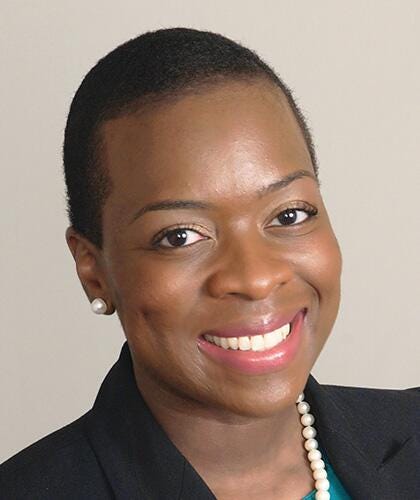Social media: A powerful tool for advocating darker skin representation and dispelling myths in Black skincare
Content creators addressing skin health myths, encouraging beauty companies to support skin of colour (1,500 words, 7 minutes)
Social media has become a tool for addressing the lack of representation of darker skin by the beauty industry, Dr. Patricia Oyetakin told the 2024 Colloquium on the Black Patient in Dermatology on August 17. Social media is also used to dispel myths about Black skin health and skin care, she said.
Dr. Oyetakin [pictured below] is a dermatologist in Atlanta, affiliated with WellSpan York Hospital. She received her medical degree from Wayne State University School of Medicine in Detroit
There is a lack of Black representation in the US$60 billion beauty industry, said Dr Oyetakin. In the U.S., Black individuals spend US$6 billion annually on beauty products, including skincare products, yet are three times more likely to be dissatisfied with product options, according to a 2021 survey by McKinsey & Company, she said. This dissatisfaction comes from the lack of specific products and a lack of access to products.
Content creators are addressing this satisfaction gap by offering immediate feedback on skincare products, said Dr. Oyetakin. Companies often use this feedback for data analytics. She gave the example of Golloria George, who creates social media content that rates the effectiveness of skincare products for darker-skinned users. George rebelled against the company Youthforia by comparing the darkest shade of its foundation to “minstrel show black.”
Dr. Oyetakin said that some companies are taking note of this social media advocacy and producing campaigns highlighting skincare and hair products created specifically for darker-skinned consumers and patients.
Social media creators also address the myths surrounding Black skin health and skincare, said Dr. Oyetakin. These include the myths that Black skin does not require sunscreen, that people with darker skin tones do not develop skin cancer and that Black skin does not age or wrinkle. In some cases, collaborations have occurred between the beauty industry, dermatologists, and social media influencers.
However, Dr. Oyetakin noted that only a minority of social media creators are board-certified dermatologists or healthcare professionals. She said dermatologists need to engage far more with social media to help dispel myths about Black skin health.
The takeaway: Social media has become an effective tool for encouraging representation and accommodation from the beauty industry for skin of colour. Social media creators have been effective at advocating for skincare products that are effective for those with darker skin. Social media also dispels myths about Black skin health and skin care.
From the literature on dermatology in skin of colour
DermTok: Who's talking sun? A cross-sectional analysis of sun protection content on TikTok
The authors of this paper note that studies have shown most dermatology-related content on the short video-sharing site TikTok is not created by board-certified dermatologists or other health professionals. To see if this trend is also seen in videos on sun protection, researchers examined TikTok videos associated with sun safety to determine the proportion produced by dermatologists.
Using the hashtags #sunscreen, #sunprotection, #spf, #skincancer, and #skinprotection, between Aug. 25 and 27, 2023, the investigators identified the top 100 videos in each category and analyzed them based on content creator. They also assessed whether the videos explicitly addressed skin of colour.
The authors found beauty or other bloggers were the most prevalent creators in this category (38.7%), followed by patients/consumers (33.7%). Only 2.8% of the videos pertained to SOC patients.
They conclude sun safety is a potential area for physicians to target on social media, and their findings underscore the need for more diverse and inclusive educational skincare content on TikTok.
Assessing the skincare needs of Asians on Reddit dermatology social media communities: An observational study
In this observational study, researchers describe the demographics and top skin concerns of Asians seeking dermatology advice on Reddit's social media platform.
Investigators identified relevant subreddits—specific topic channels on the social media site—by searching for “Dermatology” and excluding subreddits that were not specific to dermatology or were about dermatology training, particular conditions, or specific geographic areas. They then identified the top five subreddits based on the number of subscribers. The five were r/SkincareAddiction (1.5 million), r/Skincare_Addiction (1.2 million), r/SkincareAddicts (763k), r/Dermatology (58.8k), r/DermatologyQuestions (22.6k).
The researchers then screened all posts from Aug. 12, 2011, to Nov. 19, 2022, by searching for “Asian” in each subreddit, excluding posts that were duplicates, advertisements, and where the author did not identify as Asian.
In total, 280 posts met the inclusion criteria. r/SkincareAddiction had the highest number of posts, with 102 (36.43%). An upward trend in the number of posts was observed from one in 2012 (0.36%) to 130 in 2022 (46.43%). Among the posts, 168 (60%) identified age and most were between 18 to 25 years, with 85 (50.60%), 161 (57.5%) identified gender, with 82 (50.93%) males and 79 (49.07%) females, 121 (43.21%) identified the Asian subgroup, with 70 (57.85%) South Asian, 24 (19.83%) Southeast Asian, 15 (12.4%) East Asian, and 12 (9.92%) mixed Asian.
The top concerns of posts were hyper- and hypopigmentation in 74 (19.79%), acne in 50 (13.37%), and skincare routines in 41 (10.96%). The top purposes of posts (Table 2) were to seek treatment opinions in 184 (52.42%) and diagnosis in 77 (21.94%). Only 86 posts (30.71%) included a photo.
Examining racial and ethnic disparities in diagnosis and access to care in infantile atopic dermatitis in the United States: A retrospective cohort study
Researchers aimed to identify differences in the diagnosis of atopic dermatitis (AD) and access to dermatologic care by race and ethnicity in infants with AD.
This retrospective chart review examined data on infants diagnosed with AD at Boston Children's Hospital from Jan. 1, 2015, to Dec. 31, 2019. The records categorized race and ethnicity as Native American or Alaska Native, Asian, non-Hispanic Black, Hispanic, Native Hawaiian or Other Pacific Islander, non-Hispanic White, and other. Outcomes included time to diagnosis and dermatology visit from rash onset.
Investigators found significantly more non-Hispanic White infants received a prescription from their pediatrician for AD than Hispanic infants (p=0.002). Non-Hispanic Black and Asian infants waited longer to see a dermatologist after receiving a prescription for AD by their pediatrician compared to non-Hispanic White patients (p<0.001; p=0.007). Significantly more non-Hispanic Black and Hispanic infants presented to the emergency department for AD within the first year of life than non-Hispanic White patients (p<0.001; p=0.003).
VIDEO: SOCS MelanatED: Beware of social media misinformation
In this entry in the Skin of Color Society’s series of educational videos, Drs. Nkem Ugonabo, Nada Elbuluk, Prince Adotama, and Janiene Luke advise avoiding misinformation about dermatology on social media.
At the intersection of skin and society
According to a press release from the Canadian Medical Association (CMA), the organization will publicly apologize on Wednesday, Sept. 18, for its role, and the role of the medical profession, in the past and ongoing harms to First Nations, Inuit, and Métis Peoples in the Canadian health system.
The ceremony will be held on the traditional territory of the Songhees and Xwsepsum Nations.
A live stream of the ceremony will be available starting at 1:00 p.m. Pacific Time (4:00 p.m. Eastern Time). Simultaneous interpretation in English and French will be available.
The ceremony's agenda and a list of speakers and wellness resources are available on the CMA’s site.
Register today for the 10th Anniversary Skin Spectrum Summit, Oct. 4 and 5
Early-bird registration is still open for the 2024 Skin Spectrum Summit. This 10th-anniversary event will be held on October 5, 2024, at the Art Gallery of Ontario (317 Dundas St. W, Toronto, Ontario).
The Skin Spectrum Summit is a landmark educational congress of healthcare professionals dedicated to providing better dermatologic care for Canada's diverse population.
This full-day event provides education on treating patients across all six Fitzpatrick skin types, emphasizing care for Types IV to VI.
To celebrate its 10th anniversary, this year's Summit will be a two-day hybrid event held in conjunction with the Indigenous Skin Spectrum Summit—a special afternoon session on October 4, 2024, starting at 1:30 p.m., dedicated to improving the cultural competence of Canadian healthcare providers and giving practical advice on providing dermatologic care to Indigenous patients.
Speakers at the 2024 Summit include:
Dr. Andrew Alexis (New York)
Dr. Rachel Asiniwasis (Regina)
Dr. Renée Beach (Toronto)
Dr. Anna Chacon (Miami)
Dr. Joël Claveau (Quebec City)
Dr. Marissa Joseph (Toronto)
Dr. Danielle Marcoux (Montréal)
Dr. Jaggi Rao (Edmonton)
Dr. Jason Rivers (Vancouver)
Dr. Gary Sibbald (Toronto)
Readers of Skin Spectrum Weekly can take advantage of a 50% early-bird discount by registering using the button below.
This week
September is National Disease Literacy Month in the U.S.
Sept. 15 to 22 is National Eczema Week in the U.K.
Sept. 17 is World Patient Safety Day
Something to think about in the week ahead . . .
—Bruce Arians, past head coach of the Arizona Cardinals National Football League team (1952 to present)
Next week
Researchers have conducted an international review of the dermatologic literature on the use of neuromodulators in skin of colour.
If you value Skin Spectrum Weekly, why not check out Chronicle’s other publications, podcasts, and portal?
Established in 1995, The Chronicle of Skin & Allergy is a scientific newspaper providing news and information on practical therapeutics and clinical progress in dermatologic medicine. The latest issue features:
Dr. Jerry Tan (Windsor, Ont.) shares his thoughts on recent findings showing that benzoyl peroxide in acne products can break down into benzene when stored in high-temperature conditions.
Drs. Andrei Metelitsa (Calgary), Geeta Yadav (Toronto), and Rahul Shukla (Hamilton, Ont.) review several current innovations in cosmetic dermatology.
Drs. Jason Rivers (Vancouver), Cheryl Rosen (Toronto), Peter Hull (Halifax), and Jennifer Beecker (Ottawa) provide an overview of essential news in melanoma, including the use of artificial intelligence to support screening.
Plus regular features, including the popular column “Vender on Psoriasis” by dermatologist Dr. Ron Vender.
You can read a recent digital edition of The Chronicle of Skin & Allergy here. To apply for a complimentary subscription or to request a sample copy, please email health@chronicle.org with your contact information.
The Women in Dermatology e-newsletter updates readers with new findings concerning dermatologic issues affecting women and the female dermatologists who care for them. Read the current issue here.
Season three of the Vender on Psoriasis podcast with Dr. Ron Vender has begun. Listen to the new season here. In episode five, Dr. Vender discusses whether vitamin D influences psoriasis severity, sex differences in psoriatic inflammation itch, and the risk of psychiatric disorders associated with acitretin.
And if you’re looking for a web destination for all things derm, visit derm.city, “Where Dermatology Lives.” Please like, rate, review, and share it with your colleagues.










